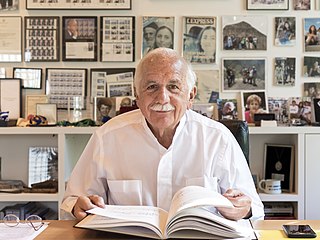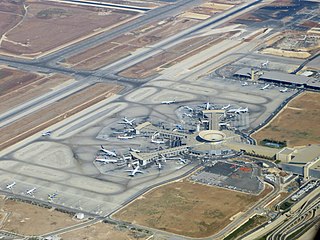
Tel Aviv-Yafo, often referred to as just Tel Aviv, is the most populous city in the Gush Dan metropolitan area of Israel. Located on the Israeli Mediterranean coastline and with a population of 460,613, it is the economic and technological center of the country. If East Jerusalem is considered part of Israel, Tel Aviv is the country's second most populous city after Jerusalem; if not, Tel Aviv is the most populous city ahead of West Jerusalem.

Moshe Safdie is an architect, urban planner, educator, theorist, and author, with Israeli, Canadian, and American citizenship. He is known for incorporating principles of socially responsible design in his 50-year career. His projects include cultural, educational, and civic institutions; neighborhoods and public parks; housing; mixed-use urban centers; airports; and master plans for existing communities and entirely new cities in North and South America, the Middle East, and Asia. He is most identified with designing Marina Bay Sands and Jewel Changi Airport, as well as his debut project, Habitat 67, originally conceived as his thesis at McGill University.

Ben Gurion International Airport, commonly known by the Hebrew-language acronym Natbag, is the main international airport of Israel. Situated on the northern outskirts of the city of Lod, it is the busiest airport in the country. It is located 45 kilometres (28 mi) to the northwest of Jerusalem and 20 kilometres (12 mi) to the southeast of Tel Aviv. Until 1973, it was known as Lod Airport, whereafter it was renamed in honour of David Ben-Gurion, the first Israeli prime minister. The airport serves as a hub for El Al, Israir Airlines, Arkia, and Sun d'Or, and is managed by the Israel Airports Authority.

Sde Dov Airport, also known as Dov Hoz Airport(IATA: SDV, ICAO: LLSD) was an airport in Tel Aviv, Israel that mainly handled scheduled domestic flights to Eilat, northern Israel, and the Golan Heights, as well as having served as a base for the Israeli Air Force (IAF). It was the largest airport in Tel Aviv proper, and the second largest in the area, after Ben Gurion Airport on the outskirts of Lod. The airport opened in 1938 and was named after Dov Hoz, one of the pioneers of Jewish aviation. It ceased operations on 30 June 2019 after a controversial, long-delayed plan came into effect to close the airport in order to build high-end residential apartments on its valuable beachfront property. Commercial flights were moved to Ben Gurion Airport and military flights were moved to other IAF bases. The airport was a focus city for Arkia Israel Airlines and Israir Airlines.

Daniel "Dani" Karavan was an Israeli sculptor best known for site specific memorials and monuments which merge into the environment.

Highway 1 is the main highway in Israel, connecting Tel Aviv and Jerusalem, and continuing eastwards to the Jordan Valley in the West Bank.

Ariel Sharon Park is an environmental park along the lines of Ayalon river, in the area between Ben Gurion Airport and Highway 20. The area is 8.5 square kilometers big, and was intended to be the "green lung" of the southern part of Gush Dan metropolin. The park was established on the former Hiriya waste dump located southeast of Tel Aviv, Israel, the Shalem farm, Mikveh Israel village and the Menachem Begin Park. After accumulating 25 million tons of waste, the Hiriya facility was shut down in August 1998. Hiriya is visible on approach into Ben Gurion International Airport as a flat-topped hill. Three recycling facilities have been established at the foot of the mountain: a waste separation center, a green waste facility that produces mulch and a building materials recycling plant. The waste dump and its surrounding area have been renovated into a large park that is still under construction.

Ben Gurion Airport railway station is an Israel Railways station located in the lower level of Ben Gurion International Airport's Terminal 3. The station opened on 10 October 2004, together with the opening of Terminal 3. The railway line extending to the northwest from the station connects it to Tel Aviv and points north, while in the other direction from the station the railway splits south to Lod and southeast to Modi'in and Jerusalem.

Jerusalem–Yitzhak Navon Railway Station, originally named Jerusalem–HaUma railway station is an Israel Railways passenger terminal in Jerusalem, located at 6 Shazar Avenue.

The Tel Aviv transportation system is seen as the hub of the Israeli transport network in terms of road, rail, and air transport. The Israeli road network partly centers on the city, with some of the country's largest highways passing through or running to the city. The city forms a major part of the country's rail network, whilst Ben Gurion International Airport located near the city is the country's largest airport. There is also a strong public transport system within the city, based primarily on bus transportation.

The Tel Aviv–Jerusalem railway is a railway line connecting the city of Tel Aviv in Israel with Jerusalem. The line serves as the main rail link between Tel Aviv and Jerusalem, complementing the old Jaffa–Jerusalem railway. As such, the railway is often referred to in Israel as the high-speed railway to Jerusalem to distinguish it from the older, longer and slower line. In spite of that name, the line is not high-speed under the definition used by the International Union of Railways: both its design speed of 200 km/h (125 mph) and its current operational speed of 160 km/h (100 mph) are below the 250 km/h (155 mph) threshold used by the UIC to define high-speed railways, and it is traversed by IR's regular rolling stock instead of the UIC requirement for specially-designed high-speed trains.

Shlomo Aronson ; November 27, 1936 – September 12, 2018) was an Israeli landscape architect. His works range from master plans for reforestation to archaeological parks and freeway planting schemes to urban plazas.

Arieh Sharon was an Israeli architect and winner of the Israel Prize for Architecture in 1962. Sharon was a critical contributor to the early architecture in Israel and the leader of the first master plan of the young state, reporting to then Prime Minister, David Ben-Gurion. Sharon studied at the Bauhaus in Dessau under Walter Gropius and Hannes Meyer and on his return to Israel in 1931, started building in the International Style, better known locally as the Bauhaus style of Tel Aviv. Sharon built private houses, cinemas and in 1937 his first hospital, a field in which he specialized in his later career, planning and constructing many of the country's largest medical centers.

The Ayalon River is a perennial stream in Israel, originating in the Judean Hills and discharging into the Yarkon River in the area of Tel Aviv.
Events in the year 1949 in Israel.

Habima Square is a public major space in the center of Tel Aviv, Israel, which is home to a number of cultural institutions such as the Habima Theatre, the Culture Palace, and the Helena Rubinstein Pavilion for Contemporary Art. The square is at the intersection of Rothschild Boulevard, Hen Boulevard, Dizengoff Street, and Ben-Zion Boulevard.

Atarim Square is a complex of buildings and a public square in Tel Aviv, Israel, designed by architect Yaakov Rechter.

Gil Har-Gil, is an Israeli landscape architect.

Daphna Greenstein is an Israeli Architect and Landscape architect. Greenstein professioned in various design and planning aspects: Landscape Architecture, Environmental Design, and Architecture. She specialized in designing a wide range of projects in the public realm.
Greenstein Har-Gil, Landscape Architecture Ltd is an Israeli landscape architecture firm.



















